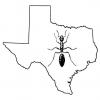First look appear to be Pseudomyrmex pallidus, but after seeing the queen to worker size ratio it is different than the normal P pallidus queen I have seen before. The worker ants are slightly larger than P pallidus too. Thanks in advance for ID.
1. Location of collection: Houston, Texas
2. Date of collection: 10/03/2015
3. Habitat of collection: Grassy with standing dead wood stem
4. Length (from head to gaster): ~ 5 mm
5. Color, hue, pattern and texture: Orange-Red
6. Distinguishing characteristics: Elongated, wasp-like
7. Anything else distinctive: Very good eye-sight with darting move
8. Nest description: Arboreal. Nesting inside hollow twig


This is Pseudomyrmex pallidus queens and workers for comparison (Shooting in closer range).





















